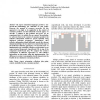Free Online Productivity Tools
i2Speak
i2Symbol
i2OCR
iTex2Img
iWeb2Print
iWeb2Shot
i2Type
iPdf2Split
iPdf2Merge
i2Bopomofo
i2Arabic
i2Style
i2Image
i2PDF
iLatex2Rtf
Sci2ools
JSW
2007
2007
User-Controlled Reflection on Join Points
Abstract—All aspect orientation languages provide a onesize-fits-all methodology for reflection on join points. However, the amount of resources necessary for this approach is too high to be applicable in the context of consumer products. In this industrial research paper, we describe a solution to this problem and prove via an experiment that it is suitable for our context. In particular, we advocate that in the context of consumer products the reflective information should be passed explicitly using dedicated reflection parameters. Furthermore, since reflective information should efficiently encode the relevant domain knowledge, the user must be in control of the type of the dedicated reflection parameters. We describe how we implemented user-controlled reflection on join points in our aspect-oriented framework AspectKoala [12] on top of the component model Koala [13]. We compare the resource consumption of different approaches to add reflective information on join points using thi...
| Added | 16 Dec 2010 |
| Updated | 16 Dec 2010 |
| Type | Journal |
| Year | 2007 |
| Where | JSW |
| Authors | Piërre van de Laar, Rob Golsteijn |
Comments (0)

